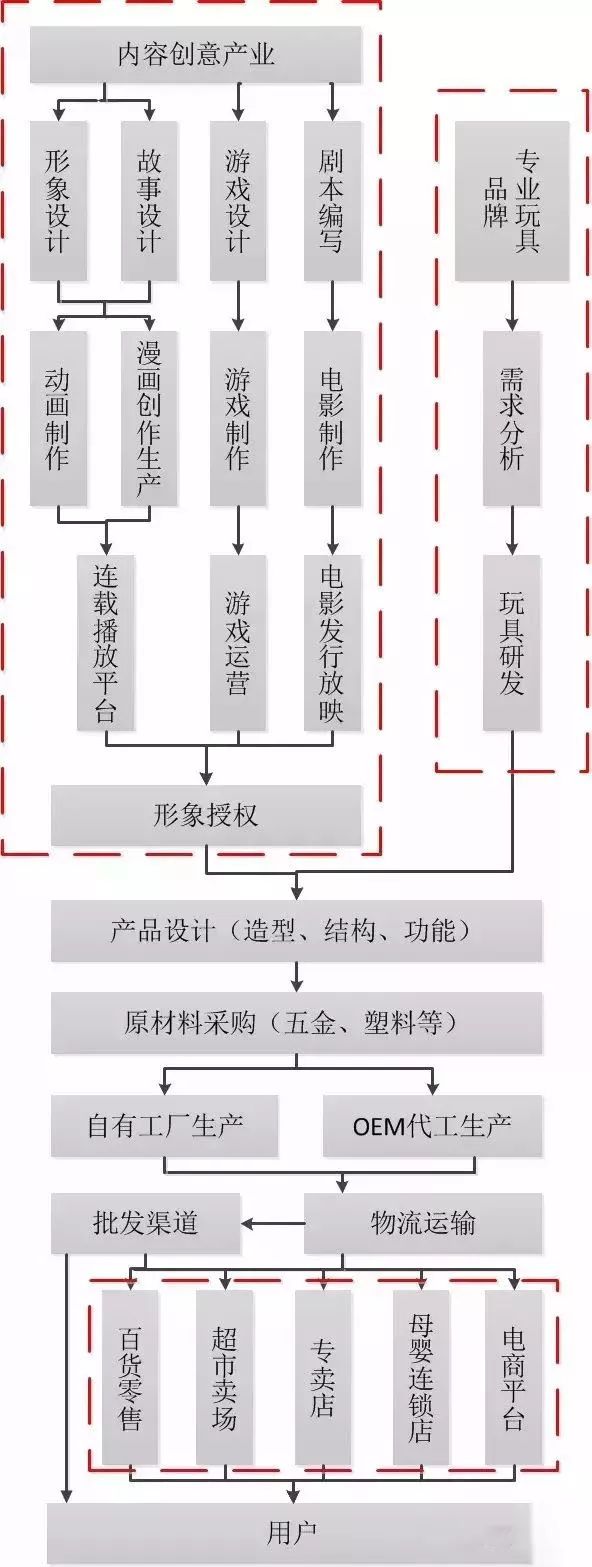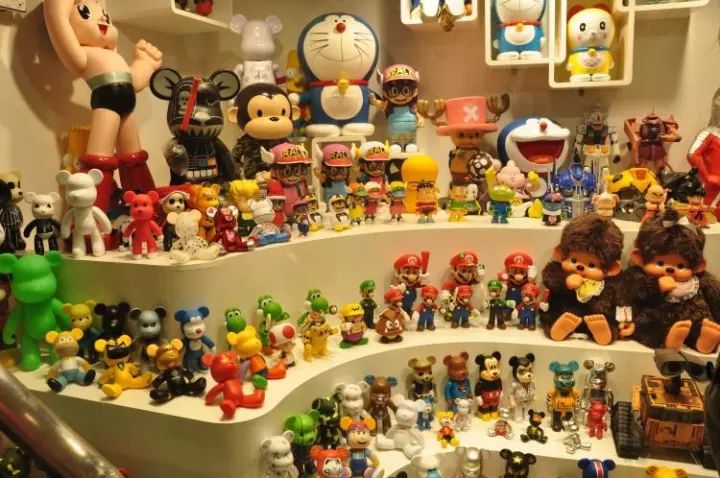There are two value chains in the toy industry. One is the toy industry value chain driven by the content industry, such as Bandai, Disney, Hasbro and other toy companies; the other is the toy industry value chain driven by R&D and design, such as the toy giant Lego.
Through the content-driven toy industry value chain, the main products are animation toys, as derivatives of the animation image. The anime image of a toy may come directly from a cartoon, may come from a popular cartoon, or it may come from a character in a certain game or film and television work. If the animation image is widely welcomed by the market, the toys derived from the anime image are likely to become hot products in the market, such as the Frozen Toys series, which became popular all over the world after the release of the ice romance last year.
The toy industry value chain driven by R&D and design, its products often highlight a certain function of the toy according to the needs of the market. For example, Lego's building block toys are easy to cultivate children's creativity and imagination, and smart toys can cultivate children's expressive ability.

one
Toy brand operation
Brand and IP are the core of toy companies, and the ability to operate brands and IP is the core competitiveness of the toy industry. From the perspective of Mattel and Hasbro's emphasis on core brands and IP, we can see that brand and IP are the targets of the giants' actual operations.
Toy giants have already been promoted in the IP industry chain: establishing core brands in the upstream, actively storing IP and cooperating with well-known brands; diversifying the manufacturing business in the midstream to focus on film and television animation manufacturing, entering the TV channel, diverting for toy products; downstream The channel and sales side will give full play to the advantages of the linkage between the upper and middle reaches, play a large-scale effect, and actively deploy emerging markets. Not only the two giants in the United States have this action, Japan's Bandai Nangong Dream, the domestic Aofei Entertainment, etc. are all starting from the initial toy or game business to carry out the IP-wide industrial chain layout.
The development of the entire industry chain does not mean blind development of toy derivatives. For different types of IP, the profit points are different. Some IP movie box office receipts are not high, and the development of game revenue is very high, but if it expands into a toy derivative or a main park, then it does not guarantee profit. Under the whole industry chain strategy, we must look at the value point of IP and choose the right IP to develop toy derivatives.

In addition to product image creation, toy companies must pay more attention to commercialization capabilities. Compared with the advantages of a company that has just entered the enterprise, a mature enterprise does not have a high quality with its own IP, but its commercial operation capability for IP and brand power accumulated in the market. China's toy manufacturing industry is not lacking creative IP image, but is short-term in the operation of commercialization, and the business operation is not mature enough. Therefore, in the process of transformation of China's toy industry, in addition to paying attention to the creation of product image, it is also necessary to enhance business. And cultural output capabilities, in order to better achieve IP cash.
Mattel, which has a large number of IPs, has segmented the brand management, such as the boy brand, the girl brand, the pre-school brand, etc., and then determines the development market of the derivatives according to the classification - the girl brand mainly develops toys such as costumes, dresses, dolls, etc.; The boy brand is the main model car, which can be used to move toys and toys, while the pre-school brand discovers “education + toysâ€. The organic integration of these IPs with derivatives has created the Mattel derivatives industry chain.

two
Toy R&D design
A wide range of toy worlds must be widely understood. The in-depth understanding of existing toys is the basis for our innovative design of toys, especially the toy products in the foreign toy market. More than half of the toys in Europe and the United States are not available in the Chinese market. Therefore, it is not enough to understand toys from the "universal" Taobao. Innovative design on the original toy product concept is the correct way to open the innovative design of toys. In fact, the basic functions of many classic toys have not changed in the past 100 years. What designers need to do is to upgrade and integrate the original toys through new artistic expressions using new technologies, new materials and new techniques.

three
Toy manufacturing
From the perspective of manufacturing, the upstream of the toy industry chain is mainly raw material suppliers, mainly including plastics industry, hardware industry, electronic parts industry and packaging industry. Toy manufacturers need to push products to consumers through distributors, so the downstream mainly includes retail, wholesale and other sales industries.
There are many toy companies, and the phenomenon of regional industrial clustering is obvious.
The most important toy production and export bases are “five provinces and one cityâ€: Guangdong, Jiangsu, Shanghai, Shandong, Zhejiang and Fujian.
In terms of product categories, Guangdong and Fujian are mainly electric and plastic toys; Jiangsu and Shanghai are mainly soft toys; Zhejiang is mainly wooden toys, forming a relatively obvious industrial cluster effect.
Among them, Guangdong Province is China's largest toy production and export region, mainly concentrated in Shenzhen, Dongguan, Guangzhou, Shantou Chenghai, Foshan Nanhai, Jieyang Jiexi and other places.
The export of toy products is characterized by “one high, three lowâ€, and the core competitiveness of the industry is not strong.
At present, toy export enterprises mainly focus on OEM OEMs. More than 70% of the toys exported by them belong to the processing of incoming materials or sample processing. Because of OEM production, such enterprises have no investment in research and development, and there is no toy safety performance analysis capability. Only engaged in simple sample processing, therefore, the brand effect of the product is not obvious, the sales means is single, the competition is severe, which directly leads to the current export of China's toy products "one high and three low", that is, high export volume, low product technology content, brand added value Low, low economic efficiency.

four
Toy logistics
Logistics loss is inevitable, and now it is basically the customer-designated logistics, they control the cost themselves. The customer finds that the loss in the freight is caused by the manufacturer to replenish them first, and then to find a logistics complaint. In the past year, the logistics services are very good. If they are damaged, they will pay compensation quickly. Generally, they will not lose a lot of money. The customer will confirm when receiving the goods. If there is any loss, the site logistics will be confirmed and the photos will be forwarded to the dealer. If there is a problem, it will be pushed first, and then it will be no longer possible. However, in order to calm down the opinions of customers, they can only suffer a loss.
In the current logistics, the barbaric and rough loading and unloading phenomenon is common. In order to effectively cope with this phenomenon, manufacturers have two choices: one is to strengthen the overall packaging material of the product, so that the product is more resistant to falling and resisting. The second is to replace the logistics company as appropriate. But in practice, choosing one is more practical for the company. The goal is to find the best results between packaging costs and logistics losses. The losses caused by the logistics process are not small, their current logistics are to use their own designated company to ensure safe and convenient transportation.

Fives
the way of buying
The sales channels of downstream toys include wholesale channels, department store retail, supermarket stores, specialty stores, maternal and child chain stores, and e-commerce platforms.
The traditional toy sales channels mainly include: first, the wholesale market; second, large department stores, which mainly sell high-end and international brand toys; third, supermarket stores, which are important stores for low-priced toys. In recent years, specialty stores, franchise chains, etc. are developing, such as Toys R Us, Leyou, and Lijia Baby, which have become one of the channels for most parents to buy toys.

six
Breaking the golden rule for local small and medium-sized toy companies
1. Take the road of differentiation and specialize in vertical fields
For example, Funkco focuses on collecting toys. Funkco does not develop IP, but through extensive cooperation with IP development companies. According to public information, Funko has signed contracts covering more than 10,000 characters, including Star Wars, Golden. The characters in the Girls, the athletes in the National Football League, even Hillary and Trump.
2. Deepen technical advantages and rationally use IP image
Such as VTech, VTech is known as the high-tech in toys. It is a technology-centered enterprise. Its toys combine electronic attributes and educational attributes, mainly for the intellectual development of young children. VTech does not create IP, nor does it focus on IP. The main advantages of its products are in the nature of technology and education.
3. Make full use of channel advantages and marketing methods
Such as McDonald's, it is not a toy producer, there is no technical advantage and no specialization in the toy field, but according to Nutrition Nibbies, McDonald's exports 1.5 billion toys every year through 35,000 stores worldwide. At present, McDonald's has 35,000 stores worldwide, covering 119 countries, and the number of shoppers entering the day is as high as 62 million. McDonald's promoted the sale of toys with its huge channel advantage.
4. Seize the niche consumers with unique creativity
For example, MGA, which competes with Mattel in the field of dolls, MGA successfully broke the doll market dominated by Barbie dolls with Bratz dolls, and once seized 40% of the doll market share. Bratz is known as the "anti-Barbie" wild hoe, compared to Barbie's "Princess Dream", Bratz's rebellious shape is closer to reality. In addition, MGA is also good at capturing the needs of niche consumers. In January 2012, a mother of a child cancer patient launched an event on Facebook, hoping that Mattel would make a bald version of Barbie to support children with cancer. This "beautiful bald Barbie" movement received great attention, and Mattel did not respond in time. In 2013, a limited edition bald Barbie was produced and donated to the American Children's Hospital. MGA quickly launched three bald Braz dolls, three bald Moxie girl dolls, and a bald Moxie boy doll. In addition, MGA also announced that for every doll sold, it will donate $1 to support the "City of Hope" organization for cancer research.

According to estimates, the manufacturer's cost is about 30% of the dealer's retail price of 199 yuan, about 60 yuan; the producer's profit is about 7%, the toy from the producer to the toy wholesaler in the circulation process, management, transportation and advertising The cost is about 18%, and it is distributed to the wholesaler. The wholesaler's cost price is about 110 yuan. From the wholesaler to the dealer's circulation process, the wholesale discount and the second transportation cost are about 20%, which is distributed to the dealer. The dealer's cost price is 150 yuan; the dealer's gross profit is about 25%, that is, the retailer's retail price is about 199 yuan; when the toy is distributed to the department store or the shopping mall's store, the store deducts about 25%-30%. In addition, the gross profit of the store (excluding the deduction point of the store) is about 20%-25%, that is, the price of the store terminal is about 300 yuan.
Non Slip Paper Drapery Tubes,Garment Laundry Clothing,White Paper Made Tubes,Paper Drapery Tubes
SHAOXING DINGLI METAL CLOTHESHORSE CO., LTD , https://www.dingliclothrack.com
![<?echo $_SERVER['SERVER_NAME'];?>](/template/twentyseventeen/skin/images/header.jpg)